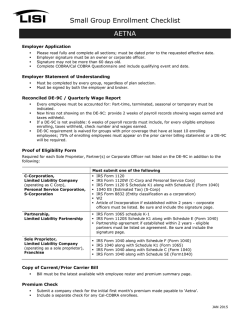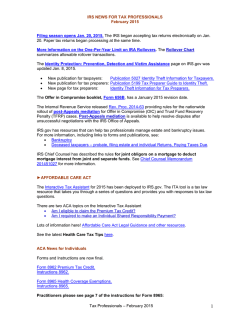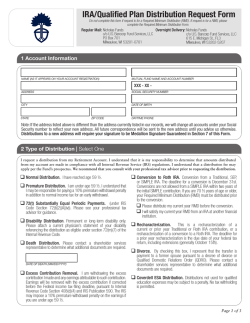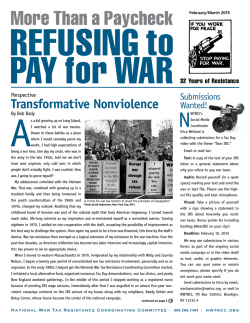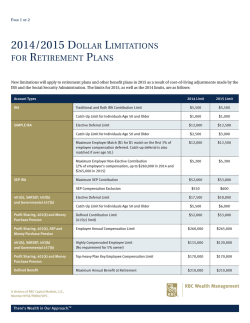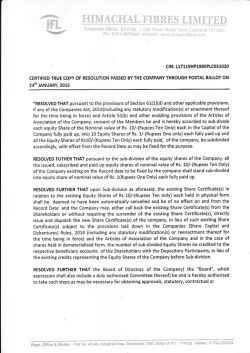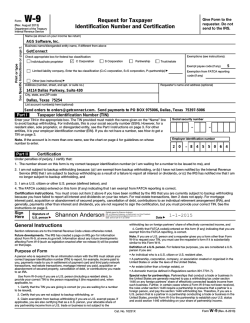
2014 Mutual Fund Tax Guide
2014 Mutual Fund Tax Guide Table of Contents 1 Tax Items of Interest 10 2014 Form 1042-S 3 2014 Form 1099-DIV 11 2014 Form 5498 4 2014 Form 1099-B 12 2014 Form 5498-ESA 6 2014 Form 1099-R 13 Special Tax Considerations 7 2014 Form 1099-Q 15 Questions and Answers 8 2014 Form 1099-INT 17 Additional Resources 9 2014 Form 592-B Dear Valued Shareholder: The purpose of this tax guide is to provide basic information about the tax forms you have received or that may be mailed to you later this year. The information on pages 312 lists the various tax forms, who will receive them, and required mailing dates. We have included a detailed explanation of each tax form, frequently asked questions and answers, and where to go for further information. Although this guide may assist you in preparing your tax return, it is not designed to provide specific tax advice or guidance. Given the scope and complexity of tax laws, you should consult your tax or financial advisor who may have knowledge of your personal financial history and who can best assist you in preparing your tax return. Tax Items of Interest The American Taxpayer Relief Act (H.R. 8), signed in December 2012, made permanent or extended several tax provisions beneficial to mutual fund shareholders. Current Tax rates on Long-term Capital Gains and Qualified Dividend Income (QDI) are shown below. Ordinary Income Tax Rate Ordinary Dividend Tax Rate 10% 15% 25% 28% 33% 35% 39.6% 10% 15% 25% 28% 33% 35% 39.6% QDI and Long-Term Capital Gains Tax Rate 0% 0% 15% 15% 15% 15% 20% Section 3406(b) of the Internal Revenue Code requires backup withholding to occur upon certain payments being made to a mutual fund shareholder, including dividends, short-term and long-term capital gains, and redemptions/exchanges. The backup withholding rate is presently 28%. Charitable Contributions The Pension Protection Act provision allowing an income exclusion of up to $100,000 for qualified charitable distributions from IRAs which were paid directly to certain charitable organizations after the IRA owner attained the age of 70 ½ was extended through December 31, 2014. Distributions from a SEP or SIMPLE IRA do not qualify for this type of designation. As of the publication date of this guide, the provision for charitable contributions has not been extended for 2015 or future tax years. 1 Maximum Contribution Limits Taxpayers can contribute up to amounts shown below for the 2014 tax year. “Catchup” contributions, for those shareholders age 50 or over by December 31, 2014 are also provided below. Please review IRS Publication 590-A for eligibility requirements. IRA Type Traditional IRA Roth IRA SEP IRA SIMPLE IRA Coverdell Education Savings (CESA) Contribution Limit $5,500 $5,500 $52,000 $12,000 $2,000 Contribution “Catch-Up” $1,000 $1,000 N/A $2,500 N/A Savers Credit If you make eligible contributions to an employer-sponsored retirement plan or to an IRA, you may be able to take a tax credit. To be eligible for the credit you must be at least 18 years of age, not a full-time student, and cannot be claimed as a dependent on another person’s federal tax return. The tax credit may be up $1,000 or up to $2,000 if married filing jointly. Please review IRS Publication 590-A and IRS Form 8880 for more details. Gift Tax Exclusion Gift tax is a tax on the transfer of property by one individual to another while receiving nothing, or less than full value, in return. The tax applies whether the donor intends the transfer to be a gift or not. The annual exclusion for gifts made to a donee during the calendar year is $14,000, for 2014 and 2015. 2 2014 Form 1099-DIV What Does Form 1099-DIV Report? Form 1099-DIV reports all tax reportable dividend, tax-exempt dividend and capital gain earned from distributions (cash or reinvested) on non-retirement accounts. If there was no tax reportable capital gain or dividend distribution, you will not receive a Form 1099-DIV. Dividend information is reported on either IRS Form 1040, 1040 A or 1040 Schedule B. Capital gain information may be required on IRS Form 1040 Schedule D. You will not receive a Form 1099-DIV if your total dividends for a fund are less than $10. Even if you do not receive Form 1099-DIV, you must still report all of your taxable dividends and capitals gains on your tax return. Who Will Receive It? Individuals, trusts, estates, partnerships, and certain other institutions. Retirement plan accounts will NOT receive this form. Required Mail Date February 17, 2015 Box Description 1a Reports total ordinary dividends, including short-term capital gains (will include amount from box 1b) 1b Reports qualified dividend income that may be taxed at a reduced rate depending on your tax bracket 2a Reports total long-term capital gains Reports a return of your initial 3 investment, also known as return of capital Reports backup withholding to 4 include on your tax return as taxes withheld 6 Reports foreign tax paid 10 Reports tax-exempt interest dividends which are reportable on line 8B of Form 1040 or 1040A 11 If applicable, reports tax-exempt interest AMT dividends. See the instructions for Form 6251, Alternative Minimum Tax – Individuals 12 If applicable, reflects the state of residency for state backup withholding 13 If applicable, reflects the state identification number for state backup withholding 14 If applicable, reports state backup withholding to include on your tax return as taxes withheld 3 2014 Form 1099-B What Does Form 1099-B Report? Form 1099-B reports redemptions or exchanges from a non-retirement or non-money market account. The information displayed on Form 1099-B is reported on the IRS Form 1040, Schedule D and Form 8949. Basis reporting for mutual funds is required on covered shares for the 2014 tax year on Form 1099-B. The section titled Not Reported to the IRS may provide cost basis information on non-covered shares. This section may provide the cost basis method for a transaction, please see tax form 1099-B Backer for further information. Gain/Loss data provided as a courtesy. This figure may require adjustment, please see the IRS instructions for Forms 8949, Schedule D and 1040 for reporting details. Who Will Receive It? All accounts with redemptions during 2014 except for retirement plans and certain corporate and institutional accounts. Required Mail Date February 17, 2015 Box Description 1a Description of property including share price and quantity sold 1b Date of acquisition of the fund shares that were sold; will be blank if shares acquired at different dates are included in the transaction or if Box 5 shows YES 1c Reports date shares sold 1d Reports net proceeds from sale 1e Reflects the cost or other basis of shares redeemed. If Box 5 shows YES, Box 1e may be blank 1f/g Shows the amount of nondeductible loss in a wash sale transaction Reports backup withholding to 4 include on your tax return as taxes withheld 5 If this box displays YES, the shares sold were non-covered (cost basis not reported to the IRS) and boxes 1b, 1e, and 1f/1g may be blank 14 If applicable, reflects the state of residency for state backup withholding 15 16 If applicable, reflects the state identification number for state backup withholding If applicable, reports state backup withholding to include on your tax return as taxes withheld 4 2014 Form 1099-B How Is Basis Reported? The 1099-B may consist of up to five reporting holding period categories or sections based on the length of time the shares depleted were held and the cost basis reporting requirements of those shares. A single transaction may display in up to four of the five holding period categories described in the example below. To identify which sections will appear on Form 1099-B, it must be determined which holding period category the depleted shares match. 1. Short-term transactions for which basis is reported to the IRS (shortterm, covered). 2. Short-term transactions for which basis is not reported to the IRS (short-term, non-covered). 3. Long-term transactions for which basis is reported to the IRS (longterm, covered). 4. Long-term transactions for which basis is not reported to the IRS (longterm, non-covered). 5. Transactions for which basis is not reported to the IRS and for which short- or long-term determination is unknown (non-covered shares for which the acquisition date and basis are unknown). Example On 09/04/2014, Mark redeemed the shares below. # of shares 1 1 1 Acquisition ShortDate /Longterm holding period Long12/5/10 term Long04/14/11 term Short08/06/14 term Reported to IRS (Covered) No No Yes Since Mark’s redemption depleted covered and non-covered shares that were both long- and short-term, his Form 1099-B will display two sections, 1) Long-term transactions for which basis is not reported to the IRS and 2) Short-term transactions for which basis is reported to the IRS. 5 2014 Form 1099-R What Does Form 1099-R Report? Form 1099-R reports distributions from a Traditional IRA, Roth IRA, SEP IRA, SIMPLE IRA and certain Qualified Plans. This information must be reported on IRS Form 1040 or Form 1040A, and may be reported on Form 8606 and Form 8329. Who Will Receive It? Individuals who took a distribution from their Traditional IRA, Roth IRA, SEP IRA, SIMPLE IRA, or certain Qualified Plans in 2014. IRA trustee to trustee transfers are not reportable. Box Description Gross distributions including 1 rollovers or transfer conversions to a Roth IRA or a recharacterized IRA contribution 2a The taxable amount for distributions from IRAs is generally not computed 4 Federal withholding Codes that identify the type of 7 distribution made. See the reverse side of 1099-R for detailed descriptions of codes 12 State withholding Required Mailing Date February 2, 2015 6 2014 Form 1099-Q What Does Form 1099-Q Report? Form 1099-Q reports distributions from Coverdell ESA accounts. Who Will Receive It? Individuals who took a distribution from their Coverdell ESA account in 2014. Trustee to trustee transfers are considered reportable on this form. Box Description Gross distributions including 1 rollovers and transfers Only displays earnings made on 2 excess contributions, otherwise not applicable for 2014 3 N/A Reports if the distribution in Box 1 4 was a trustee to trustee transfer Required Mailing Date February 2, 2015 7 2014 Form 1099-INT What Does Form 1099-INT Report? Form 1099-INT reports certain bank deposit-type interest dividends on nonretirement accounts. See the appropriate 1040 tax return instructions to determine the proper manner in which to report this information to the IRS. Box Description 1 Reports interest income 4 Reports backup withholding to include on your tax returns as taxes withheld Who Will Receive It? Individuals, trusts, estates, partnerships, and certain other institutions. Retirement plan accounts will NOT receive this form. Required Mailing Date February 17, 2015 8 2014 Form 592-B What Does Form 592-B Report? Form 592-B reports State of California backup withholding on redemptions and long-term capital gains. Who Will Receive It? Accounts subject to federal backup withholding and also reflect a residence of California. Box Description Part IV Total income subject to backup Box 1 withholding. Amount matches Box 1d on IRS Form 1099-B or Box 2a on IRS Form 1099-DIV Part IV Reports total backup Box 3 withholding for the State of California Required Mailing Date February 2, 2015 9 2014 Form 1042-S What Does Form 1042-S Report? Form 1042-S reports dividends and capital gains from taxable accounts and distributions from IRA and Qualified Plan accounts paid to certified nonresident aliens. Who Will Receive It? Foreign investors who are not U.S. citizens. Required Mailing Date March 16, 2015 Box 1 2 3 3a 3b 4 4a 4b 7 10 14b 17 Description Income code Gross income paid Chapter 3 withholding – Y/N Chapter 3 exemption code Chapter 3 tax rate Chapter 4 withholding – Y/N Chapter 4 exemption code Chapter 4 tax rate Federal tax withheld Total withholding credit Recipient’s country code Recipient’s Governmental Issued ID Number (GIIN), if any 10 2014 Form 5498 What Does Form 5498 Report? Form 5498 reports IRA contributions, rollovers, conversions, and recharacterizations. These amounts are reported on IRS Form 1040, 1040A, or 8606. Who Will Receive It? Individuals who contributed to a Traditional, Roth, SEP, or SIMPLE IRA for 2014. Trustee to trustee transfers will not appear on this form. Required Mailing Date June 1, 2015, except for fair market value information, which is supplied via annual statement by February 2, 2015. Box Description Traditional IRA contributions 1 made in 2014 and through April 15, 2015 for 2014 2 Rollover contributions Amount converted or reconverted 3 to a Roth IRA from a Traditional, SEP, or SIMPLE IRA Amount recharacterized from one 4 IRA type to another 5 Fair market value as of 12/31/2014 7 Type of IRA SEP IRA contributions made in 8 2014 SIMPLE IRA contributions made in 9 2014 10 Roth IRA contributions made in 2014 and through April 15, 2015 for 2014 11 Will be selected if a Required Minimum Distribution is required to be taken for tax year 2015 11 2014 Form 5498-ESA What Does Form 5498-ESA Report? Form 5498-ESA reports Coverdell ESA contributions, rollovers, and transfers. Who Will Receive It? Individuals who contributed to a Coverdell ESA account on behalf of a beneficiary for the tax year 2014. A shareholder who transferred assets from one custodian or trustee to another will also receive this form. Box Description Coverdell ESA contributions made 1 in 2014 and through April 15, 2015 for 2014 Rollovers and transfers made in 2 2014 Required Mailing Date April 30, 2015 12 Special Tax Considerations Dividends from U.S. Government Obligations Some states do not tax their residents on mutual fund income received that is earned directly from U.S. Government obligations. Short-term capital gain distributions, although treated as ordinary income, are generally not eligible for state tax-exemption. A statement may accompany your Form 1099-DIV indicating the percentage of income your fund earned that was attributable directly to U.S. Government obligations. Alternative Minimum Tax The Alternative Minimum Tax (AMT) was created to prevent excessive use of tax deductions and credits. Its goal is to ensure that individuals who benefit from these deductions pay a minimum amount of federal income tax. Refer to the instructions for Form 1040 or Form 6251 to determine if this tax applies to you. The AMT calculation begins with your regular taxable income and adjusts for certain “tax-preference” items. One of these “tax-preference” items that would be added back to your regular taxable income is tax-exempt interest from private activity bonds. Private activity bonds are municipal bonds issued to benefit private, for-profit operations. If you own shares of a fund that invests in private activity bonds, you must include that portion of the funds distributions that are attributable to private activity bonds as a “tax-preference” item in your AMT calculation. If a fund invests in private activity bonds, a letter will generally be sent that reports to its shareholders the amount of distributions subject to the AMT. Capital Losses Taxpayers who redeemed mutual fund shares at a capital loss during the year may be able to use those losses to offset other capital gains or, in some cases, ordinary income. The IRS has created several rules in order to discourage loss-oriented selling. Two of these rules, wash sales and long-term capital gain distributions, are detailed below. Wash Sales If you purchase shares of a mutual fund, including reinvested dividends or capital gains, within 30 days before or after you redeemed shares of the same mutual fund for a loss, the redemption will be considered a “wash sale” and some or all of your capital loss will be deferred. The amount of your deferred loss increases the cost basis of the shares purchased which created the wash sale. When those shares are subsequently sold the deferred loss is then allowed. Please consult your tax advisor for more information about wash sale rules. 13 Long-Term Capital Gain Distributions Capital gain distributions from a mutual fund are generally reported as long-term capital gain regardless of how long you owned shares in a fund. However, if you owned shares for less than six months, received a capital gain on these shares, and sold them at a loss, part or all of the loss on the sale of the shares, which would normally be short-term based on the holding period, may be recharacterized as long-term instead. The amount of the loss equal to or less than the capital gain distribution is the amount which will be recharacterized as long-term. The amount of the loss greater than the capital gain distribution remains short-term. 14 Questions and Answers Q: How can I request duplicate tax forms? A: After February 17, 2015, you can contact U.S. Bancorp Fund Services, LLC to receive duplicate copies of your tax forms. Q: What do I do with the Cost Basis information I received? A: If you redeemed shares from a taxable account during 2014, your form 1099-B may include cost basis information. Please remember, cost information is required only for covered shares purchased on or after January 1, 2012 and only those shares are reported to the IRS. It remains your responsibility to calculate and report basis information to the IRS for non-covered shares, generally acquired prior to January 1, 2012. Please see the IRS instructions for Forms 8949, Schedule D and 1040 for details on how to report basis information. Q: Why is the mailing due date for Form 5498 June 1st? A: The due date is extended to allow reporting of 2014 Traditional and Roth IRA contributions that can be made until April 15, 2015. Fair market value information is provided on your year end statement mailed by February 2, 2015. You will only receive a Form 5498 if a contribution, rollover, recharacterization, or conversion was reported for 2014. Q: At what point can I no longer recharacterize a Roth IRA for the 2014 tax year? A: A Roth IRA can be recharacterized through October 15, 2015. Q: What is a capital gain distribution and how is that different from a capital gain that is incurred when shares of my account are sold? A: A Fund Capital Gain Distribution can occur when a fund buys and sells stocks and other securities within the fund’s portfolio. This activity may create a net capital gain for the fund. This capital gain distribution is taxable for non-retirement accounts. A Shareholder Capital Gain Distribution occurs when the shareholder sells shares for a gain in a taxable, non-retirement, non-money market account. Q: Do I have to report reinvested capital gains and dividends on a non-retirement account? A: Yes, capital gains and dividend distributions are considered income in the year they are distributed regardless whether they are paid in cash or reinvested. The amount of the reinvested dividends and capital gains are then added to the cost basis when a redemption occurs. This is to avoid being taxed twice on the same dollars. 15 Q: Why are SEP and SIMPLE IRA contributions that were made in 2015 for the 2014 tax year not on Form 5498? A: IRS rules state that only contributions made to a SEP and SIMPLE IRA during the calendar year are reported on Form 5498. Only contributions made during the 2014 calendar year will be reported on the 2014 Form 5498, regardless of which tax year those contributions were directed. Q: What happens if I make an excess contribution? A: You will receive Form 5498 or Form 5498-ESA that details the total amount of your contribution. If the excess contribution is removed, you will receive Form 1099-R or Form 1099-Q detailing the removal of that excess, including any earnings. Please consult IRS Publications 590 and 970 for more information regarding IRS penalties associated with excess contributions. Q: Why was there backup withholding on my taxable account? A: Generally, backup withholding applies when the Fund did not receive either a properly completed application or IRS Form W-9. Another reason is that the IRS may have instructed the Fund to withhold due to a TIN/Name mismatch on your account or due to your failure to pay federal taxes. Q: Do I have to report capital gains and dividends on an IRA account? A: No, if they were reinvested in the same IRA. Yes, if taken as a cash distribution. Q: What tax forms are mailed to nonresident aliens? A: Form 1042-S is mailed to nonresident aliens who received Fund capital gain or dividend distributions on their taxable account or liquidated assets from a retirement account. A nonresident alien is not a U.S. citizen. Q: Where can I get more information on completing my tax return? A: Please refer to the Additional Resources section in this tax guide for more information, or consult a tax advisor. 16 Additional Resources IRS General Contact Download forms, instructions and publications at www.irs.gov. General information inquiries can be made at 800-829-1040. IRS Tele Tax Topics Touch tone service on topics, 24 hours/day, 7 days/week at 800-8294477. See the IRS Form 1040 instructions or IRS Publication 910 for a complete list of Tele Tax Topics. Topic Number 155 307 309 310 404 409 410 412 413 424 451 553 556 557 558 610 652 Subject Forms/Publications Backup withholding Roth IRA Contributions Coverdell ESA Dividends Capital Gains and Losses Pensions and Annuities Lump-Sum Distributions Rollovers from Retirement Plans 401(k) Plans IRAs Tax on a Child’s Investment Income Alternative Minimum Tax Tax on Early Distributions from Traditional and Roth IRA’s Tax on Early Distribution from Retirement Plans Retirement Savings Contributions Credit Notice of Underreported Income Tax Forms Forms, instructions and publications can be found at your local IRS office, bank, post office, library, or by calling the IRS Forms Distribution Center at 800-TAXFORM. Key IRS Publications Publication Publication Title Number 3 17 54 505 514 515 525 526 530 550 554 560 590-A 590-B 907 929 970 Armed Forces’ Tax Guide Your Federal Income Tax (For Individuals) Tax Guide for US Citizens and Resident Aliens Abroad Tax Withholding & Estimated Tax Foreign Tax Credit for Individuals Nonresident Aliens and Foreign Entities Taxable and Nontaxable Income Charitable Contributions Tax Information for Homeowners Investment Income and Expenses Tax Guide for Seniors SEP, SIMPLE and Qualified Plans IRA Contributions IRA Distributions Tax Highlights for Persons with Disabilities Tax Rules for Children & Dependents Tax Benefits for Education 17
© Copyright 2025
